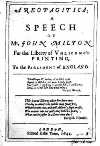 Best known for his epic poem Paradise Lost, Milton, a 17th-century English poet, was also a writer of several political and moral pamphlets. More than two decades before his poetic masterpiece was published, Milton wrote Areopagitica, his best known prose work. One of the great arguments in favor of the freedom of the press, it was published in 1644 in response to his dissatisfaction with the strict censorship of the press exercised by Parliament. For what is the pamphlet named? Discuss
Best known for his epic poem Paradise Lost, Milton, a 17th-century English poet, was also a writer of several political and moral pamphlets. More than two decades before his poetic masterpiece was published, Milton wrote Areopagitica, his best known prose work. One of the great arguments in favor of the freedom of the press, it was published in 1644 in response to his dissatisfaction with the strict censorship of the press exercised by Parliament. For what is the pamphlet named? Discuss
Source: The Free Dictionary
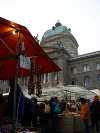
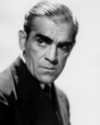 London native William Henry Pratt adopted the stage name Boris Karloff while touring as an actor in Canada. After settling in Hollywood in 1919, he began acting in silent films and achieved stardom playing the monster in Frankenstein (1931). Thereafter typecast as a horror movie villain, Karloff went on to appear in more than 100 films. His most famous television performance was in the 1966 animated special How the Grinch Stole Christmas, in which he voiced which characters?
London native William Henry Pratt adopted the stage name Boris Karloff while touring as an actor in Canada. After settling in Hollywood in 1919, he began acting in silent films and achieved stardom playing the monster in Frankenstein (1931). Thereafter typecast as a horror movie villain, Karloff went on to appear in more than 100 films. His most famous television performance was in the 1966 animated special How the Grinch Stole Christmas, in which he voiced which characters?  Light is any wavelength of electromagnetic radiation, though the word is commonly used to refer to the visible light spectrum. The human eye typically perceives electromagnetic wavelengths between 400 and 700 nanometers, interpreting them as a range of colors from red to violet. Light is understood to exhibit both particle and wave properties, and the fundamental particle, or quantum, of light is called the photon. What is the scientific study of light called?
Light is any wavelength of electromagnetic radiation, though the word is commonly used to refer to the visible light spectrum. The human eye typically perceives electromagnetic wavelengths between 400 and 700 nanometers, interpreting them as a range of colors from red to violet. Light is understood to exhibit both particle and wave properties, and the fundamental particle, or quantum, of light is called the photon. What is the scientific study of light called? 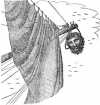 Before turning to piracy, Blackbeard, whose real name was probably Edward Teach, likely worked as a privateer in the War of the Spanish Succession. While marauding in the West Indies and along the Atlantic coast, Blackbeard enjoyed the protection of North Carolina’s governor—who partook of the booty. A British naval force eventually killed Blackbeard and took his head back to England as proof. Legend has since romanticized the notoriously cruel pirate. When was his wrecked ship rediscovered?
Before turning to piracy, Blackbeard, whose real name was probably Edward Teach, likely worked as a privateer in the War of the Spanish Succession. While marauding in the West Indies and along the Atlantic coast, Blackbeard enjoyed the protection of North Carolina’s governor—who partook of the booty. A British naval force eventually killed Blackbeard and took his head back to England as proof. Legend has since romanticized the notoriously cruel pirate. When was his wrecked ship rediscovered? 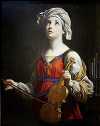 According to her apocryphal acts, which date from the fifth century,
According to her apocryphal acts, which date from the fifth century, 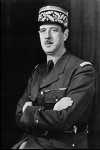 De Gaulle was a French general and statesman. He left France after it fell to the Germans in WWII and started the Free French movement in England. He returned to France after the liberation of Paris and headed two provisional governments before resigning in 1946. When an insurrection in Algeria threatened to bring civil war to France, he returned to government, helped establish the Fifth Republic, and became its first president in 1958. What was his role in the “Empty Chair Crisis”?
De Gaulle was a French general and statesman. He left France after it fell to the Germans in WWII and started the Free French movement in England. He returned to France after the liberation of Paris and headed two provisional governments before resigning in 1946. When an insurrection in Algeria threatened to bring civil war to France, he returned to government, helped establish the Fifth Republic, and became its first president in 1958. What was his role in the “Empty Chair Crisis”? 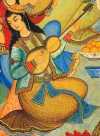 The tar is a long-necked lute found in Iran and throughout the Caucasus region. Its music was believed to cure a number of physical maladies and induce philosophical moods that compel listeners to reflect upon life. The tar’s double-bowl shape is carved from mulberry wood, and a thin membrane of stretched lambskin covers the top. It has a number of adjustable frets as well as three double courses of strings. Tar, Persian for string, is the root for the names of what other instruments?
The tar is a long-necked lute found in Iran and throughout the Caucasus region. Its music was believed to cure a number of physical maladies and induce philosophical moods that compel listeners to reflect upon life. The tar’s double-bowl shape is carved from mulberry wood, and a thin membrane of stretched lambskin covers the top. It has a number of adjustable frets as well as three double courses of strings. Tar, Persian for string, is the root for the names of what other instruments?